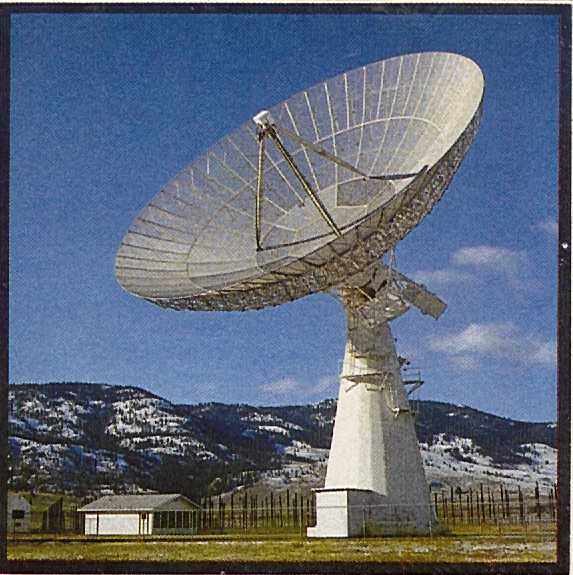
26-metre telescope. (NRC)
WHY A RADIO OBSERVATORY?
At the Dominion Radio Astrophysical Observatory, astronomers are investigating the universe, continuing a study that had its beginning thousands of years ago. Through the millennium, a concept of the universe has evolved which includes planets orbiting about the sun; stars as other suns at enormous distances, sharing space with gigantic clouds of gaseous material, and together forming the structure of our galaxy, the Milky Way; and other galaxies beyond our own, at unthinkable distances and in vast numbers, stretching out, one beyond the other, to the very edge of the observable universe. A modern astronomer works within this conceptual framework and is concerned with understanding the physical processes occurring in the universe, processes that lead to the formation and evolution of galaxies and to the birth and death of stars within those galaxies. This study is known as astrophysics and is directed towards an understanding of the universe of which we are a part, as well as the use of cosmic space as a gigantic laboratory where conditions of density, temperature and pressure go far beyond those we can achieve in our earth-bound laboratories.
For thousands of years, the universe has been studied by examining the light arriving at the earth from the stars, gas clouds and galaxies. In the past two decades, however, technology has given us the tools to capture and interpret other forms of electromagnetic radiation: radio waves, X-rays, infrared radiation and gamma rays. These all provide information on regions of the universe that are invisible to our eyes, and so increase our understanding.
The Dominion Radio Astrophysical Observatory was established in 1959 to explore the universe using radio techniques. It is located at White Lake, a short distance from the city of Penticton, British Columbia, at a secluded site selected carefully to give the Observatory protection from the interfering effects of man-made radio signals.
Radio telescopes must be big, much bigger than optical telescopes (those receiving light waves) for two reasons. First, the wavelength of radio waves ranges from millimetres to kilometres, many thousands of times greater than the wavelength of light waves. In order not to get a very blurred picture of the universe, the size of a radio telescope must be scaled up accordingly. Second, the radio waves emitted from celestial objects carry very little energy, and radio telescopes with a large collecting area must be used to capture enough energy for a "signal" to be detected. There are three large radio telescopes at the Observatory, each representing a different technique for collecting energy from a large area.
 26-metre telescope. (NRC) |
THE 26-METRE TELESCOPE
The largest "dish" telescope at the Observatory is 26 metres in diameter. Its curved surface is a mirror which reflects the incoming radio waves to the focal point near the top of the tripod. Here a small antenna collects the radio energy and feeds it to a sensitive radio receiver. The receiver boosts the weak signal which is then sent down a cable to the control building, where it is recorded for later analysis.
The 26-metre telescope is mainly used to receive radio waves of 21 -centimetre wavelength. At any instant, it records the radio emission from an area of sky about the size of the full moon. The telescope can be pointed in any direction above the horizon by motors that drive it around two perpendicular axes, and it can "track" a certain object in the sky as the earth rotates.
It is used for studies of diffuse clouds of hydrogen gas in our galaxy by observing the 21 -centimetre-wavelength radio waves that are emitted by hydrogen atoms. In addition, clouds of interstellar gas that have been heated by newly-formed stars have been investigated. The high temperature of these clouds results in very agitated motions of their atoms and electrons, producing radio emission. Superimposed on this general emission from the hot gas are weak radio signals, at specific wavelengths, from atoms other than hydrogen. Studies of these "trace" elements will provide insight into the composition of gas clouds such as the one out of which the sun and solar system formed.
 Long-baseline array. (NRC) |
LONG-BASELINE INTERFEROMETRY
For some astronomical problems, for example studies of distant quasars, images having detail far greater than that obtained in optical photographs are needed. For a radio telescope to attain such a "resolving power" it must have dimensions of many kilometres - a structural impossibility. In 1967, a group of Canadian astronomers, including Observatory staff, pioneered a technique for linking two widely separated telescopes to form effectively one telescope having a great resolving power. In this technique, called long-baseline interferometry, the radio signals received at the two antennas are recorded on video tape, along with precise timing information. By later synchronizing and playing the video tapes back, the two antennas are linked together without the necessity of a direct electrical connection between them - a technical impossibility considering the distance involved, sometimes thousands of kilometres.
The26-metre telescope is occasionally used as one antenna in long-baseline-interferometer observations of distant objects that have extremely small apparent sizes. The same technique can also be used to measure slight changes in the separation of the antennas in the interferometer, or small variations in the earth's rotation rate - important observations for studies of the movement of the earth's crust.
Currently, staff members of the Observatory are engaged in the design of a new telescope based on the long-baseline interferometer concept. It is an array of large dishes spanning Canada, and will provide images of distant galaxies and quasars having a thousand times more detail than the best optical photograph.
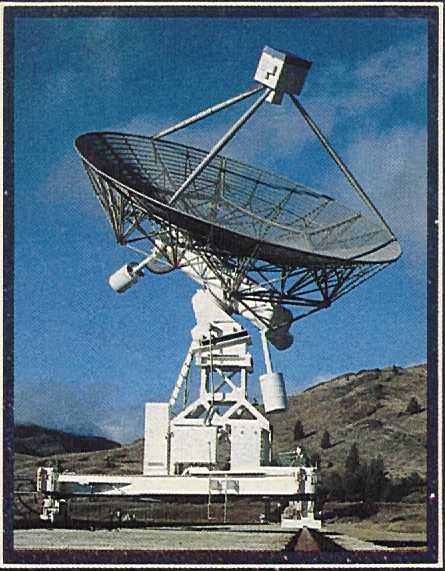 Sythesis radio telescope. (NRC) |
THE SYNTHESIS RADIO TELESCOPE
The principal telescope of the Observatory consists of four individual antennas (one of which is shown above, also see front cover of the brochure), each 9 metres in diameter. They are situated along an east-west line 600 metres in length and two of the antennas are moveable along a railway track. Working together as a team, these four antennas form the equivalent of a single telescope more than half a kilometre in diameter.
An actual telescope this large could not be built as a single structure for it would sag under its own weight, but its collecting area can be "synthesized", or built up bit-by-bit, by using the four smaller antennas. We use the earth's rotation plus movement of the antennas along the railway track to achieve this. In a daily observation during which the four antennas are kept pointing at the patch of sky being studied, the three more eastern antennas, as seen from space, are swept around the western antenna. The signals that are collected correspond to three "rings" of a large aperture 600 metres in diameter. By daily changing the positions of the two antennas on the railway track, different rings are swept out, and after 35 days of observing, the full large aperture has been sampled. The collected signals are then combined to provide the equivalent of the signal that would have been obtained by a single large telescope. This approach is known as "aperture synthesis".
The synthesis telescope is completely controlled by a computer and various observational and maintenance programs are run one after the other so that the telescope is in operation 24 hours a day. In the month required to build up the signals required for a set of images (over one hundred, each corresponding to a different radio wavelength) of a patch of sky, some 16 million numbers will have been collected by the computer.
SOME OBJECTS STUDIED WITH THE SYNTHESIS TELESCOPE
An optical photograph of the Andromeda Galaxy is shown, lower right. This is a system of hundreds of billions of stars, a neighbour in space of our own Milky Way galaxy. Above the optical picture is a radio image of the Andromeda Galaxy, (lower left) to approximately the same scale, but made using radio waves of 21 -centimetre wavelength. Atoms of hydrogen, by far the most abundant element in the universe, emit radio emission of this particular wavelength.
|
|
Before radio images were obtained, our knowledge of the Andromeda Galaxy was restricted to that gained by studying the light emitted by its stars and gas clouds. Seen through radio "eyes", it is obvious that the hydrogen clouds are most prominent in the outer regions of the galaxy and almost non-existent in the region where the bulk of the visible stars are seen. The radio telescope reveals a galaxy more than 1 50,000 light years in diameter.
The specific wavelength of the hydrogen emission permits astronomers to measure the motions of the hydrogen clouds. These measurements show that the Andromeda Galaxy is slowly rotating, with the outer hydrogen clouds requiring over a billion years for one revolution.
 Milky Way (optical) (NRC) |
 Milky Way (radio) (NRC) |
The synthesis telescope is uniquely suited to the observation of objects of large apparent size (similar to that of the moon). Amongst such objects in our Milky Way are the expanding blast waves that result when aging stars run out of fuel, suddenly collapse and then explode. Studies of these objects, known as "supernova remnants", can provide many clues to the internal corn position of stars and their evolutionary history. Earlier in this leaf let is a radio image of the supernova remnant known as CTB-1. The radio emission arises from the energetic particles and magnetic fields trapped in the blast wave which is rushing into the space surrounding the exploded star at a speed of hundreds of kilometres per second. The explosion of the star occurred thousands of years ago and may have been seen by our primeval ancestors as a brilliant point of light in the sky, lasting for many nights. The study of supernova remnants is a major field of research for Observatory astronomers and visiting scientists who use the synthesis telescope.
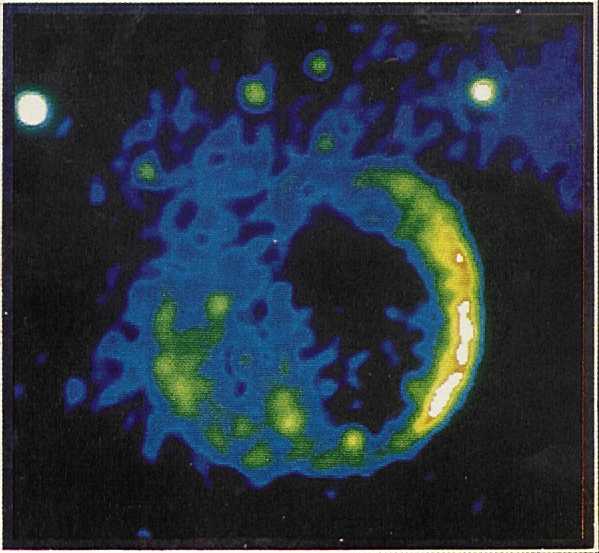 Supernova remnant CTB-1 (NRC) |
Just as the energetic events accompanying a star's death are of interest to astronomers, the processes leading to the birth of a star are equally fascinating. The collapse of diffuse clouds of gas (as seen in the above radio image of the Andromeda Galaxy) into glowing clumps of hydrogen that eventually become stars is also an active field of study at the Observatory.
THE 22-MHZ "T" ANTENNA
The vast array of wooden poles covering the ground in a giant "T" is another of the Observatory's large radio telescopes. It was designed and built two decades ago to survey the whole sky in a search for cosmic sources of radio emission at a wavelength of 14 metres (a frequency of 22 MHz). The telescope was used in the mid-1 960's during a sunspot minimum, since only then can waves of such a long wavelength penetrate the earth's atmosphere.
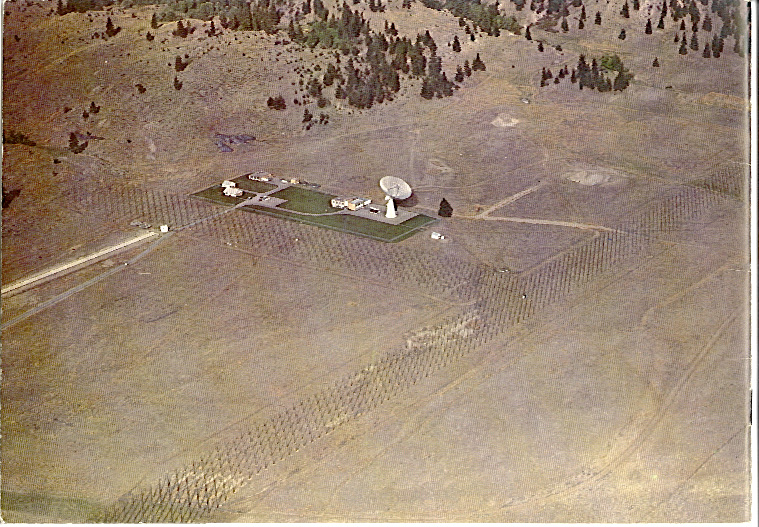 The 22-Mhz "T" antenna (NRC) |
The array, 1.3 kilometres long and over 65,000 square metres (about 100 hockey rinks) in area, collects the radio emission from a patch of sky about four times the area of the full moon. As the earth rotates, the patch scans across the sky. The 22-MHz "T" antenna cannot be tilted to point in different directions, but the observed patch of sky can be moved north or south by electrical changes in the antenna. This technique, combined with the earth's rotation, gives access to the whole sky.
Several hundred radio sources were measured during the survey, most of them distant galaxies and quasars. Also mapped was the radio emission from within our own galaxy, radio emission produced by electrons moving at nearly the speed of light and forced, by the weak magnetic fields that pervade our galaxy, to follow spiralling paths through space. In the illustration above, a composite optical photograph of our galaxy, the Milky Way, is shown in comparison with a radio picture, to approximately the same scale, obtained with the 22-MHz "T" antenna. The black areas in the figure are regions of the southern and extreme northern sky not observable from the latitude of Penticton.
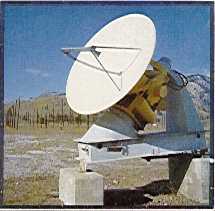 Solar telescope (NRC) |
THE SOLAR TELESCOPE
To the south of the large 26-metre telescope, a small radio telescope (shown above right) tracks the sun on its daily path across the sky. This telescope records the radio emission of the sun at a wavelength of 11 centimetres.
Solar radio emission arises in the hot gases of the solar atmosphere. Occasionally violent radio "bursts" occur when changes in the solar magnetic field create local "hot spots". These events are accompanied by the ejection of high energy particles from the sun. After passing through the vast expanse of space between the sun and earth, these particles encounter the earth's upper atmosphere, and can affect long-distance radio communications. The observations made at the Observatory are combined with observations made at other institutions around the world to provide a prediction service for solar-related effects in the earth's atmosphere.
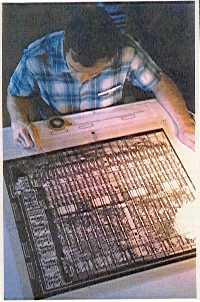 Checking layout of a new integrated circuit (NRC) |
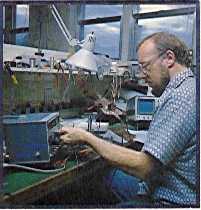 Testing new electronic components. (NRC) |
TECHNICAL SUPPORT
The heart of any modern telescope is the maze of micro-circuits and electronic components in which the observed signals are first converted to electrical signals and finally to numbers which the astronomer can use to confirm, refute or modify his theories. Many of these devices are unique and must be designed and created by the engineers and technicians of the Observatory staff.
Just as important as the "hardware" specialists are the computer programmers - the "software" specialists - who create and develop the complex computer programs that are used in the collection and analysis of astronomical data.
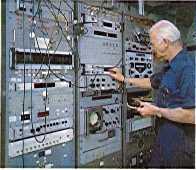 Adjustment of atomic clocks. (NRC) |
TIMEKEEPING
Clocks have always been an indispensable part of the instrumentation of an observatory because the accurate pointing of telescopes requires an exact knowledge of the time of day. Ours is no exception, and the illustration below shows a technician adjusting the Observatory's atomic clocks. Looking like no ordinary clocks, these instruments are based on the precise oscillations of atoms as they emit or absorb radiation and can be read to better than a millionth of a second. Such a clock, if running since the beginning of recorded history, would today be in error by less than a few seconds.
OTHER OBSERVATORY FACILITIES
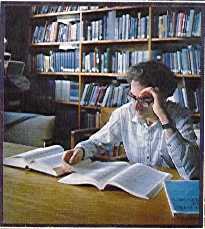 Observatory Library (NRC) |
Aside from the staff of astronomers and technicians who keep the telescopes, electronic instruments and computers operating, an observatory m ust provide the means by which the observations and theoretical interpretations are published so that astronomers world-wide can share the results. This requires a skilled support staff having off ice-machine, photographic and library expertise. The library plays a crucial role in the production of scientific knowledge. It is here, in reading the publications of the world's scientific institutions, that the researcher gains the clues and insight required to integrate his contributions into the international body of knowledge.
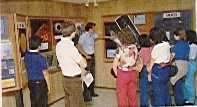 Visitors' center (NRC) |
Visitors to the Observatory are urged to tour the "Visitors' Centre", a building containing displays explaining the research conducted at the Dominion Radio Astrophysical Observatory, as well as at other centres of astronomical research.
Reprinted courtesy of National Research Council of Canada